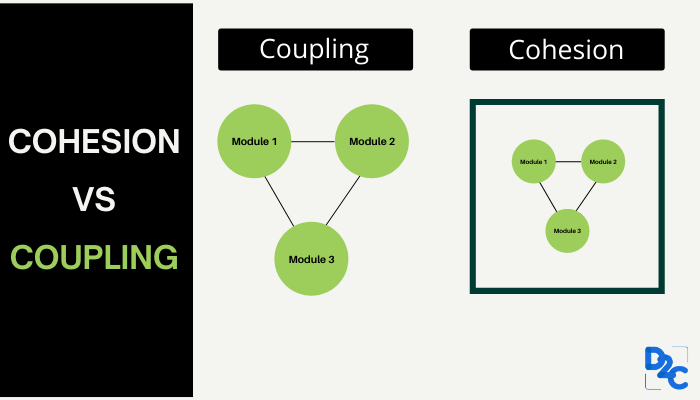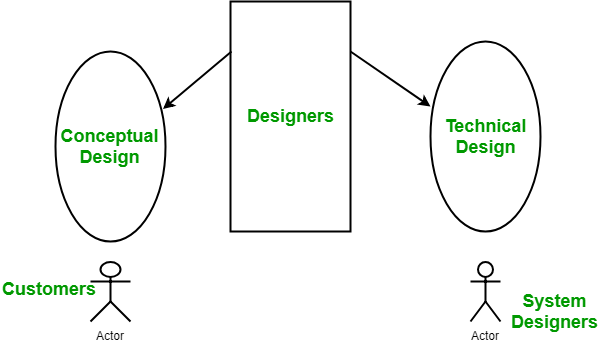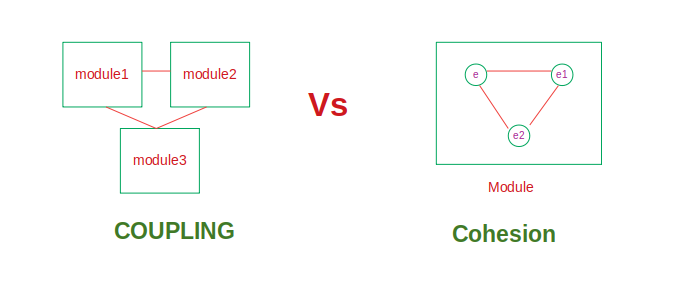Explain Different Types of Cohesion and Coupling
Logical cohesion Logical cohesion is when parts of a module are grouped because they are logically categorized to do. The cohesion indicates how the complete focus is imparted on just one entity that is a module and its relative functional strength.

Difference Between Cohesion And Coupling D2c
The modules share related control data in control coupling.

. An element outputs some data that becomes the input for other element ie data flow between the parts. In software engineering the coupling is the degree of interdependence between software modules. It represents relationships within the module.
Today we look at two such criteria. It is an intra module concept. In theory the guideline looks pretty simple.
Cohesion represents the degree to which a part of a code base forms a logically single atomic unit. Difference between Coupling and Cohesion in Tabular form Coupling The measure of how a module depends on other modules is known as coupling. The classes have high cohesion.
Coupling Cohesion and there Types 1. The classes have low coupling II. It is an inter-Module concept.
Cohesion is the indication of the relationship within module. Loosely coupled are made up of units that are independent or almost independent. First I will explain what coupling and cohesion are with examples in software.
Cohesion is a measure of functional strength of a module. It is concept of intra-module. It is an ideal situation.
Every essential element for a single computation is contained in the component. In essence high cohesion means keeping parts of a code base that are related to each other in a single place. Low coupling at the same time is about separating unrelated parts of the code base as much as possible.
We say that an entity is cohesive if it performs a single well-defined. It is an intra-module concept. In a good design the various component parts eg.
It can be viewed as highly coupled loosely coupled and uncoupled. Teams would be more independent each working on its own folder. Coupling shows the relative independence among the modules.
Cohesion has many types but usually highly cohesion is good for software. When modules are highly cohesive a high quality software is built. In short low cohesion means the module is trying to do too many things.
In common coupling common data. It occurs naturally in. Coupling measures interaction between modules whereas Cohesion focuses on interaction within a module.
Based on these possible dependencies the coupling in software engineering is classified into six different types of coupling. Low Coupling would mean that greater independence of individual modules while low cohesion would mean a weaker set of functional interdependence within a said module. Coupling is also the indication of the relationships between modules.
Cohesion is a degree quality to which a component module. Explain Coupling and Cohesion in Software Engineering with Code Example and Use Cases. Modules are independent if they can function completely without the presence of the other.
Coupling is defined as the degree of interdependence of modules while Cohesion is defined as the degree of strength of individual modules in relation to others. Various type of coupling. Functional independence means that a cohesive module performs a single function or task.
Increased cohesion is considered to be good for the software. A module having low coupling and high cohesion is said to be functionally independent of other modules. A functional cohesion performs the task and functions.
Coupling represents the degree to which a single unit is independent from others Coupling is the number of connections between two or more units. Each folder could also be versioned and released independently of others. Coupling is the indication of the relationships between modules.
High cohesion low coupling guideline. In a good design the various component parts eg. Differentiate between Coupling and Cohesion.
Cohesion is the indication of the relationship within module. An indication of the strength of interconnections between program units. Highly coupled have program units dependent on each other.
Key Differences Between Cohesion and Coupling Cohesion is creating interconnections within the module while coupling involves building connectivity between the modules. Types of Cohesion. The data coupling is possible by parameter passing or data interaction.
This resource can be a functional behavior a common interface a common field in a user interface the data picked from a field and shared between two modules a transaction shared between two modules etc. In this post we will understand the difference between cohesion and coupling. Two modules that are tightly coupled.
Recap of What We Have Done. The primary characteristics of neat module decomposition are low coupling and high cohesion. High coupling means modules are tightly interconnected via many complex interfaces and information flows.
Cohesion In computer programming cohesion refers to the degree to which the elements of a module belong together. It represents the functional strength of the modules. Cohesion shows the modules relative functional strength.
In this post you will learn how to write better code by looking at two important qualities in software engineering called cohesion and coupling.

Difference Between Coupling And Cohesion Differbetween

No comments for "Explain Different Types of Cohesion and Coupling"
Post a Comment